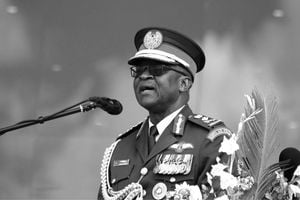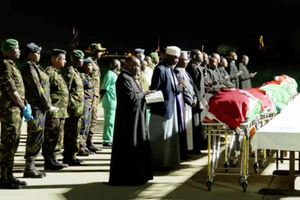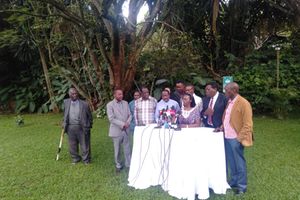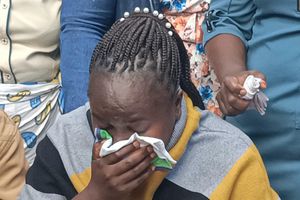Breaking News: Former Lugari MP Cyrus Jirongo dies in a road crash
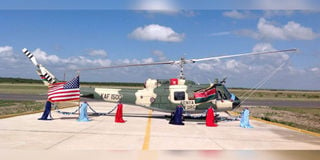
A Kenya Air Force Bell Huey II helicopter. Gen Francis Ogolla and nine others were aboard such a helicopter when it crashed on Thursday.
The Bell Huey II used by Chief of Defence Forces (CDF) Francis Ogolla, who will be buried in Siaya County tomorrow, was a US-made helicopter that has been involved in most of the recent air accidents in Kenya.
It is an upgraded version of Bell UH-1H Multi-mission medium lift helicopter.
The CDF and the President ordinarily use one of the three Italian-made AW-139 delivered to Kenya in 2020 or Aerospatiale SA330H Puma that have been in service as VIP transport for years.
It is not yet known why Gen Ogolla used the ill-fated Bell Huey II instead of the usual VIP Puma or the AW139 acquired during President Uhuru Kenyatta’s term.
A refurbished Bell Huey II helicopter crashed in Boni forest on September 19, 2023. Another went down in Lamu in 2018 while a Fennec AS55 C3 crashed in Chemolingot, Baringo County, on July 20 last year.
Manufactured by Bell Helicopter, a subsidiary of Textron, Bell Huey II is a logistical transport support helicopter weighing 2,252 kilogrammes. Its carrying capacity is 2,210 kilos.
It has a flat cabin floor that can be configured for whatever logistical purpose intended, removable crew doors, crash resistant fuel cells, a wire strike protection system, rollover bulkhead, auto-rotation and chip detection.
Operated by one or two pilots, the Bell Huey II can attain a maximum cruising speed of 196 kilometres per hour, with a flight range of about 455 kilometres. It can carry 12 to 14 soldiers.
The two blade semi rigid tail rotor is equipped with a digital cockpit supporting night vision and increased horsepower for greater flexibility. It can remain airborne for 156 minutes.
Six of such Bell Huey II were delivered to the Kenya Defence Forces by the US in November 2016.
Countries that have acquired Bell Huey II in recent years include Lebanon, which bought 18 in 2014, Colombia Air Force bought seven in 2016 and Kazakhstan acquired two in 2016.
Uganda also acquired five Bell Huey II from the US through Foreign Military Sale programme in 2017.
Two of eight Huey helicopters acquired from the US in 2015 for $106 million (Sh14.2 billion in today’s rates) have crashed in Kenya in six months, taking at least 14 lives.

A Kenya Air Force Bell Huey II helicopter. Gen Francis Ogolla and nine others were aboard such a helicopter when it crashed on Thursday.
Bell, the maker of the helicopter, sent a brief statement to the Nation query on the accident.
“We extend our deepest condolences to those involved and their loved ones. Bell stands ready to assist with support as needed,” the company said in a statement signed by Alexis Baird, a senior Public Relations Strategist, Global Communications.
Kenya acquired the aircraft as it sought ways of responding to terrorism. When the final batch of two Huey helicopters arrived in 2017, it was a grand event that involved the US embassy.
Said the embassy in a statement: “These helicopters have the exceptional capacity to operate in hot and high- elevation environments, while being rugged enough to endure extended operations with minimal maintenance. They will reinforce the KDF’s air assault capability to deploy Kenyan Rangers and other quick reaction forces.”
The first batch that arrived in December 2016 were received with pomp. There was a flypast at Laikipia Air Base, Nanyuki, attended by then-US Ambassador to Kenya Robert Godec.
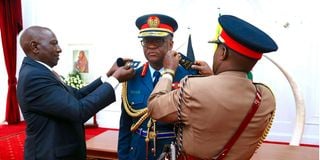
President William Ruto with Chief of Defense Forces Francis Ogolla at a previous function.
The Huey helicopter can be traced to years of America’s war in Vietnam. It stemmed from a demand from the US army to the air force for the creation of a helicopter that would facilitate the airlifting of wounded soldiers.
That explains the roominess of the helicopter and its toughness. In many descriptions by Bell, it is a workhorse.
In terms of naming, the Huey is known as the UH. Currently, Bell is selling the UH-1Y model, which it says “combines combat-proven power with dependable components – arming you for the toughest missions”.
Apart from the helicopter, the other issue is who was travelling with Gen Ogolla at the time of the tragedy.
The KDF boss was with Brig Swaleh Saidi, Col Duncan Keittany, Lt-Col David Swae, Maj George Benson Magondu, Cap Sora Mohammed, Capt Hillary Litalii, Sr-Sgt John Kinyua Mureithi, Sgt Cliphonce Omondi and Sgt Rose Nyawira.
Tana River Governor Godana Dhadho Gaddae, a former military officer who talked to the Saturday Nation yesterday, said it is normal for the CDF to have a lean team of junior officers “because there were seniors conversant with the situation on the ground to brief him”.
“It is normal for people to raise concerns because a general has died in an air crash, the first ever such incident in Kenya. Wherever he travels to, there are senior military officers who receive him, led by a Major General, in this case the head of the Western Command,” Maj (rtd) Dhadho said.
“The Major General has several Brigadiers and Colonels under him. They brief the CDF appropriately. It would not have made sense for the General to carry along senior officers from the Defence Headquarters when there were others conversant with whatever was happening on the ground. It was not necessary for the CDF to carry other generals because his personal assistant and military attache had arranged his itinerary and coordinated his movements. The staff he had were adequate to travel with” .
Governor Dhadho said because of the CDF’s rank and the fact that he was an Air Force officer and a pilot, it means the serviceability of the helicopter was on very high standards.
Only an air accident investigation can reveal what caused the plane to fall from the sky.
“We may not be qualified to comment on the aircraft and why he boarded it. We have no information of whether a mechanical issue had been raised or if it was shot at during the flight,” the Tana River County boss said.
“If it had developed a notable mechanical problem, the CDF – a pilot himself – and other staff would have sought another helicopter. But the trip went well until they embarked on their return journey. It could have developed a problem. A helicopter does not just come down like that.”
The two survivors of the Thursday accident, an insider at the Department of Defence (DoD) informed the the Nation, were likely saved by sitting at the back of the helicopter, as protocal demands.
The General – the highest ranked officer on the flight – would ordinarily sit immediately behind the pilots and in the middle, so as to have a front view of the situation.
“The copter with 12 people onboard means the CDF sat behind the pilots with officers by his side. The rear row had four officers with two others sitting on the left and right side, next to the exit doors,” explained the officer at DoD.
The crash came just months after a Kenya Air Force helicopter went down in Baringo County.
The two crashes have exposed the sorry state of Kenya’s military aircraft.
The helicopter had been in operation for 33 years and was ferrying Ministry of Defence employees who had accompanied Cabinet Secretary Aden Duale on a tour of the North Rift.
KDF said the helicopter hit a tree and crashed during take-off, and that all persons onboard escaped unhurt.
“Most military equipment, including aircraft, have been reported to be in a sorry state but officials have failed to address this rot, which clearly endangers our lives,” the DoD official, who requested, anonymity said.
Politicians frequently post pictures on social media using Kenya Air Force helicopters.
The Baringo copter was one of the eight Fennec AS550C3 and AS350B3 models that were acquired from the United Arab Emirates in the early 2000s.
They were manufactured by France’s Eurocopter Engineering/Ecureuil in 1990.
Global military magazine, Jane’s Defence, reveals that KDF has 14 Aerospatiale SA 330G transport helicopters, two Ukrainian made copters, Canadian De Havilland DHC Buffalo tactical planes that have been in service since 1977, three Canadian Bombardier DHC Dash 8, and Fokker 70 for VIP transport.
The most common aircraft under use by KDF are the 1969-made French Airbus SA330 medium transport and Puma assault helicopters.
The US recently delivered the 1959-manufactured Bell UH-1. The US-made light single engine Cessna 208 (Caravan) aircraft have been essential in the KDF pilot training.
The military has 11 Chinese Harbin Y-12 utility transport planes delivered in 1997, one of which was fitted with special cameras and converted into an aerial patrol plane.
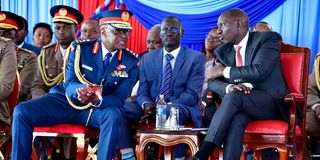
President William Ruto with the late Chief of Defence Forces General Francis Ogolla at the National Defence College in Karen on May 25, 2023.
KDF also operates 30 fighter-jets, including 17 F-5E and 4-5F Northrop Tiger models from the US that have been operational since 1978.
The Kenya Air Force has also operated Scottish Aviation Bulldog trainer aircraft – commonly known as Bulldog103 and Bulldog127 – since 1972.
Some have been replaced by the German-made Grob 120A.
There is also the Brazilian-made Embraer EMB-312 Tucano Mk 51 counter insurgency aircraft that have been part of the fleet since 1990 when 13 of them were delivered.
The KDF fleet also comprises French Lenardo C-27 Spartan and American multi-purpose MD 500 (Hughes 500) helicopters.
Some of these have over the years crashed under unclear circumstances, although mostly attributed to ageing and underserviced machines. Among the recent cases is the crash in Masinga on July 14, 2020, which killed two soldiers.
The ministry issued a statement saying the helicopter was for training purposes.
However, neither the ministry nor military officials gave an explanation of the cause of the crash of the US-made light attack helicopter gunship MD 530F.
It was among six gunships that the Army acquired in January, 2020.
In June 2021, some 10 KAF personnel died while 13 others were badly injured when their Mi 171E helicopter crashed during training in Kajiado County.
In April 2006, a military cargo plane that was carrying a high-level delegation on a peace mission crashed in Marsabit County as it attempted to land in bad weather, killing 14 people on board, including five MPs.
The lawmakers were Bonaya Godana, a former Foreign Affairs minister who at the time was deputy Leader of Official Opposition – Kanu – Mirugi Kariuki (assistant minister for internal security), Titus Ngoyoni (assistant minister for regional development authorities) and local MPs Abdi Sasura and Guracha Galgalo Boru.
The crash of the Chinese-made Y-12 aircraft plunged the country into national mourning. Then-government spokesman, Alfred Mutua, who is now the Tourism Cabinet Secretary, attributed the accident to “heavy rains in the area”.
Dr Gerald Majany, a security consultant, says the near-obsolete equipment could impede KDF’s operations in fighting off security threats posed by groups like al-Shabaab.
“The use of old or poorly maintained machines not only slows our forces down but places them at a high risk. This matter must be fixed fast. Before we embrace modern warfare technology like the use of drones, Kenya must invest in intelligence gathering,” Dr Majany says.


